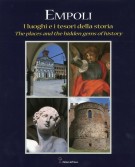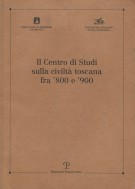Empoli I luoghi e i tesori della storia The places and the hidden gems of history
| Autore/i | Alessandro Naldi, Leonardo Giovanni Terreni, Paolo Pianigiani | ||
| Editore | Editori dell'Acero | Luogo | Firenze |
| Anno | 2012 | Pagine | 190 |
| Dimensioni | 25x30 (cm) | Illustrazioni | ill. colori n.t. - colors ills |
| Legatura | cart. edit. con sovracc. ill. colori - Hardcover with dustjacket | Conservazione | Nuovo - New |
| Lingua | Italiano/Inglese - Italian/English text | Peso | 2000 (gr) |
| ISBN | 8886975716 | EAN-13 | 9788886975711 |
| Prezzo | 45.00 € | Sconto | 20% |
| Prezzo scontato | 36.00 € | ||
Aggiungi al carrello
Fotografie di Alena Fialova.
Finalmente anche Empoli ha un libro che la racconta, la descrive, la fa immaginare. A chi non la conosce e a chi la conosce. Ma soprattutto a chi vuole bene a questa città, per chi c’è nato, per chi ci vive. La storia parte da quando qui c’erano gli etruschi, poi i romani e poi il Medioevo con i suoi misteri. E la rinascita dopo l’oscurità, il libero comune (piccolo, per carità, ma libero…) poi la resa a Firenze, con il Marzocco che iniziò a dominare il tetto della chiesa, sullo stemma antico che ancora oggi ritroviamo nel Museo di Collegiata. E via fino ai giorni nostri, di ora.
Una nuova immagine per Empoli. Un nuovo modo di guardare. Foto straordinarie, per la gran parte inedite, che non descrivono ma raccontano: le opere d’arte mai così definite, gli aspetti e gli angoli delle vie, dei monumenti. Masolino da Panicale, maestro senza pari ai suoi tempi, venne da noi a dipingere, chiamato dalla ricca famiglia dei Federighi, che avevano lo stemma simile ai Medici e che venivano di là d’Arno. Il Siemoni azzarda l’ipotesi che lavorasse in primis in Sant’Agostino (Cappella di S. Elena e la lunetta con la Madonna) e poi al grande “Uomo dei dolori” nel Battistero di San Giovanni. E i fratelli Antonio e Bernardo Gamberelli da Settignano, soprannominati “Rossellino”dal colore dei capelli, che han lasciato da noi capodilavori assoluti. Nessuno li aveva mai fotografati e interpretati così: il Fonte Battesimale con i due puttini in bella vista, o il muto colloquio fra l’Angelo e l’Annunciata, in Sant’Agostino.
E il testo, con la traduzione inglese, a narrare lo snodo degli eventi, i personaggi, le lotte interne ed esterne, con una novità: gli scontri fra i poteri religiosi, quelli dei preti (che riportavano al Vescovo di Firenze e da lì al Papa), riuniti nella potentissima Collegiata, e i frati. I poverelli di San Francesco (i Cappuccini di Pantaneto e i Francescani di Santa Maria a Ripa) tenuti fuori dalle mura da apposita carta autoritaria scritta sulle pergamene (a favore del Pievano), a quelli (ricchi o quasi) Agostiniani, che non disdegnavano ostentare il bello, che da sempre ha il suo prezzo. E che, non a caso, riuscirono a entrare, anche se confinati fin sotto le mura castellane. (Paolo Pianigiani)
Finally, Empoli too has a book that tells about it, describes it, makes us imagine it. To those who do not know it and to those who know it. But above all to those who love this city, for those who were born there, for those who live there. The story starts from when the Etruscans were here, then the Romans and then the Middle Ages with its mysteries. And the rebirth after the darkness, the free municipality (small, for heaven's sake, but free ...) then the surrender to Florence, with the Marzocco that began to dominate the roof of the church, on the ancient coat of arms that we still find today in the Collegiata Museum . And so on up to the present day, right now.
A new image for Empoli. A new way of looking. Extraordinary photos, for the most part unpublished, which do not describe but tell: the works of art that have never been so defined, the aspects and corners of the streets, of the monuments. Masolino da Panicale, a master without equal in his time, came to us to paint, called by the wealthy Federighi family, who had the coat of arms similar to the Medici and who came from beyond the Arno. Siemoni ventures the hypothesis that he worked primarily in Sant'Agostino (Chapel of St. Helen and the lunette with the Madonna) and then on the great "Man of Sorrows" in the Baptistery of San Giovanni. And the brothers Antonio and Bernardo Gamberelli from Settignano, nicknamed “Rossellino” by the color of their hair, who left us absolute masterpieces. No one had ever photographed and interpreted them like this: the Baptismal Font with the two cherubs in plain sight, or the silent conversation between the Angel and the Annunciation, in Sant'Agostino.
And the text, with the English translation, narrates the junction of events, the characters, the internal and external struggles, with a novelty: the clashes between the religious powers, those of the priests (which reported to the Bishop of Florence and from there to Pope), gathered in the powerful Collegiate, and the friars. The poor people of San Francesco (the Capuchins of Pantaneto and the Franciscans of Santa Maria a Ripa) kept outside the walls by a special authoritarian paper written on the parchments (in favor of the Pievano), to those (rich or almost) Augustinians, who did not disdain to flaunt the beautiful, which has always had its price. And that, not surprisingly, they managed to enter, even if confined to the castle walls. (Paolo Pianigiani).
(T-CA)
Potrebbero interessarti anche...





